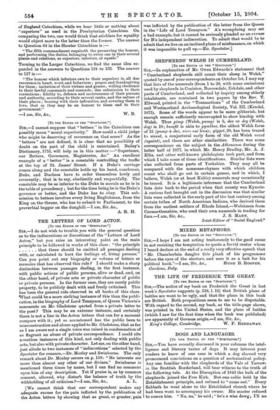SHEPHERDS' WELSH IN CUMBERLAND.
SIB,—In explanation of Mr. Owen Edwards's statement that "Cumberland shepherds still count their sheep in Welsh," quoted by one of your correspondents on October 1st, I may say that lists of the numerals (from 1 to 20, with some omissions) used by shepherds in Coniston, Borrowdale, Eskdale, and other parts of Cumberland, and collected by inquiry among elderly inhabitants, are contained in two papers by the Rev. T. Ellwood, printed in the " Transactions " of the Cumberland and Westmorland Archaeological Society, Vol. III. (Kendal, 1875). Some of the words appear to be mere gibberish, but enough remain sufficiently uncorrupted to show kinship with Welsh. Thus pimp (Welsh, pump) is 5, dee or deg (Welsh, deg) is 10; bumfit is akin to pymthec, the oldest Welsh form of 15 (pump + dec, em-yrs sal aiza); giggot, 20, has been traced to vicent, a conjectural early form of the old Welsh ucent (ugaint), and there are other similarities. There was some correspondence on the subject in the Athenaum during the latter half of 1877, in which Mr. Henry Bradley, Mr. A. J. Ellis, and other well-known philologists took part, and from which I take some of these identifications. Similar lists were also collected from parts of Yorkshire. They may all be compared with the nonsense-rhymes with which children count who shall go out in certain games, and in which, I believe, Welsh (or at least Keltic) numerals may occasionally be traced. It is a legitimate inference that the Cumberland lists date back to the period when that county was Kymric. A curious fact brought out in the discussion was that similar lists were collected in the early part of the last century among certain tribes of North American Indians, who derived them from the earliest settlers of Rhode Island,—Welshmen from Carmarthenshire, who used their own numerals in trading for
Joint-Editor of "Social England!'










































 Previous page
Previous page